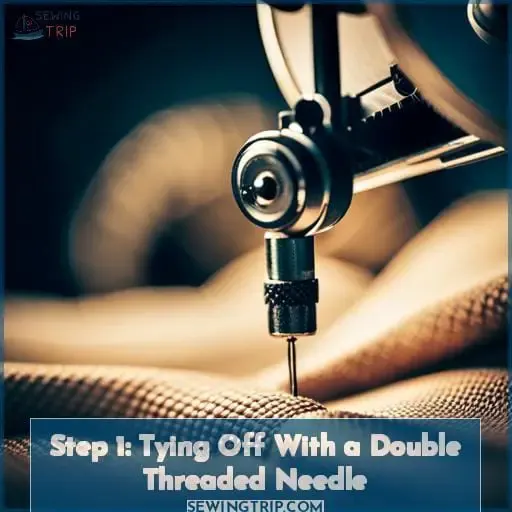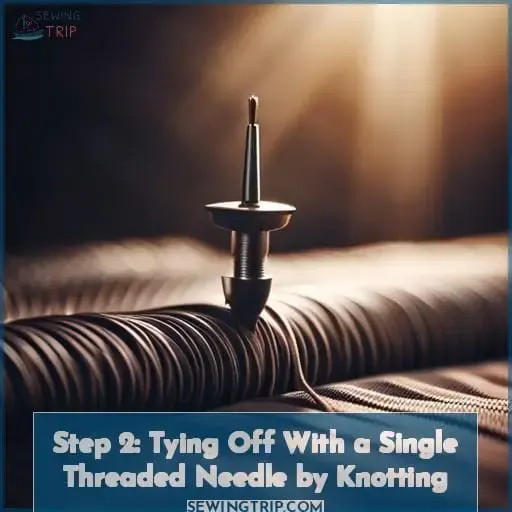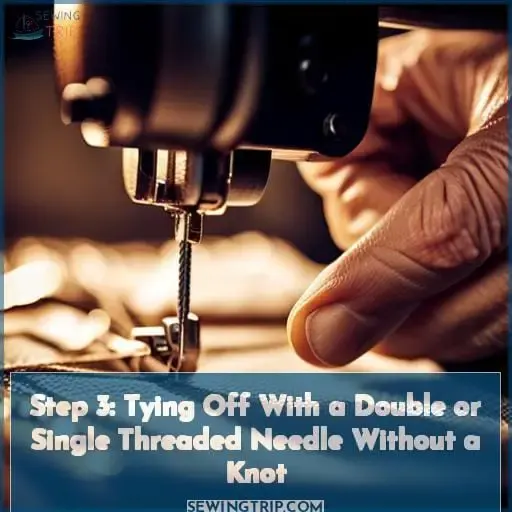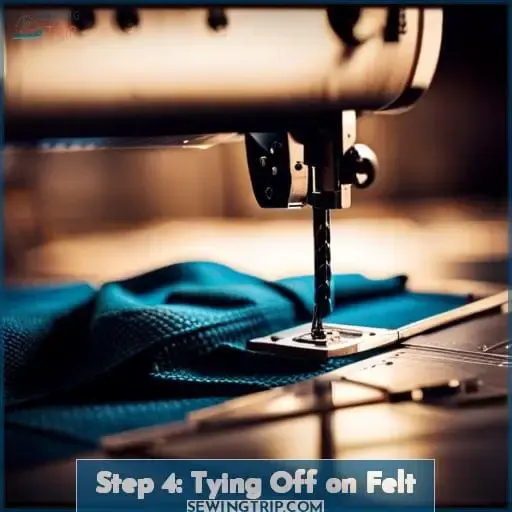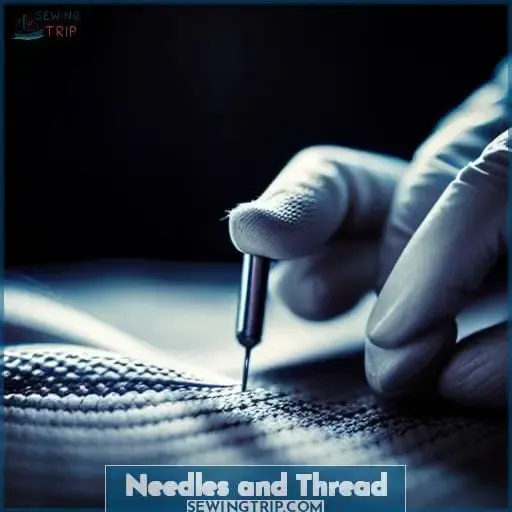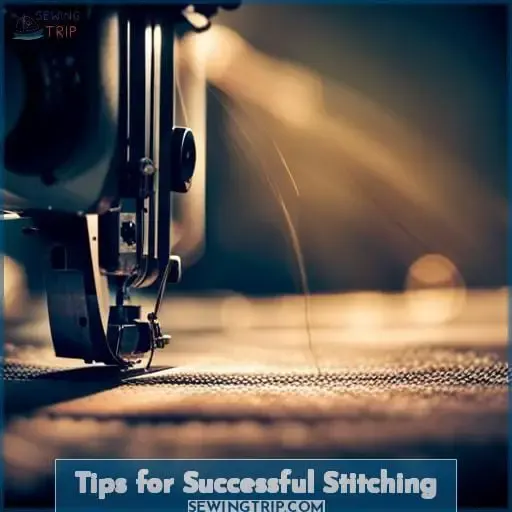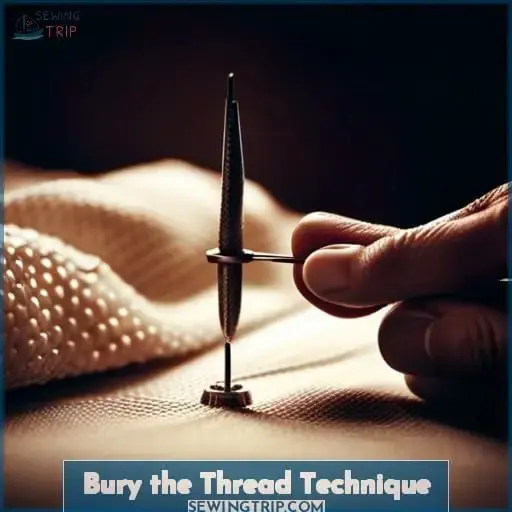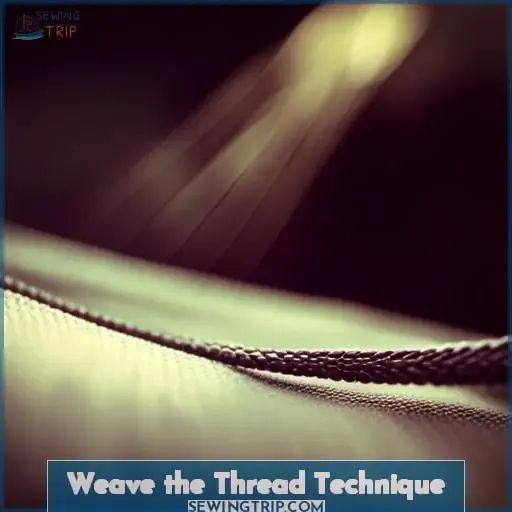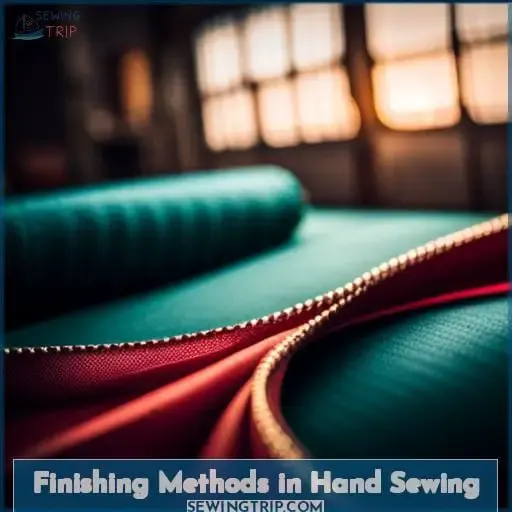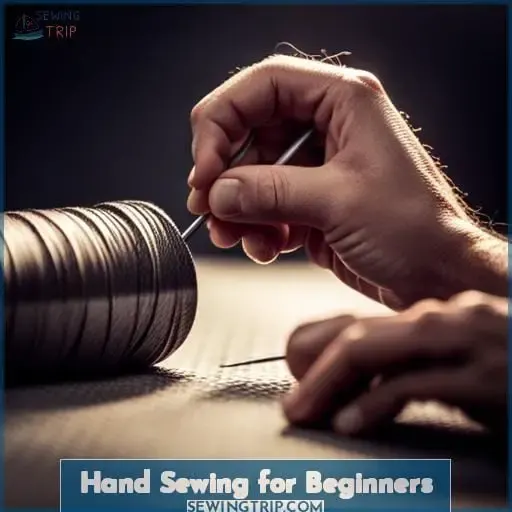This site is supported by our readers. We may earn a commission, at no cost to you, if you purchase through links.
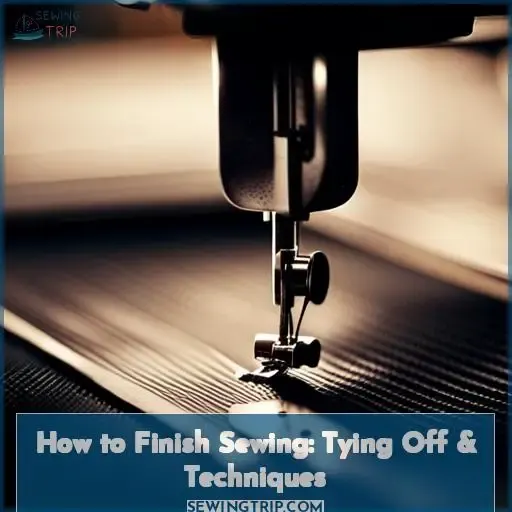 Imagine the satisfaction of finishing a sewing project with expert precision. In this article, you’ll discover essential techniques for tying off your stitches like a pro.
Imagine the satisfaction of finishing a sewing project with expert precision. In this article, you’ll discover essential techniques for tying off your stitches like a pro.
Whether you’re working on running or back stitches, we’ve got you covered. From tying off with and without knots to hiding thread ends on felt, these methods will ensure your work is durable and visually appealing.
Say goodbye to loose threads and hello to mastery in finishing sewing projects!
Table Of Contents
- Key Takeaways
- Step 1: Tying Off With a Double Threaded Needle
- Step 2: Tying Off With a Single Threaded Needle by Knotting
- Step 3: Tying Off With a Double or Single Threaded Needle Without a Knot
- Step 4: Tying Off on Felt
- Needles and Thread
- Tips for Successful Stitching
- Bury the Thread Technique
- Weave the Thread Technique
- Finishing Methods in Hand Sewing
- Hand Sewing for Beginners
- Frequently Asked Questions (FAQs)
- Conclusion
Key Takeaways
- Importance of leaving adequate thread for secure tying off.
- Understanding needle and thread compatibility.
- Proper thread management for impeccable seams and comfortable tying off.
- Mastery of tying off basics, especially for beginners.
Step 1: Tying Off With a Double Threaded Needle
To begin tying off your sewing project with a double threaded needle, cut the thread below the needle for easy fastening.
When choosing your needle, opt for one that’s suitable for your fabric type to maintain proper tension.
After cutting the thread, tie the two halves together, leaving a tail length of 2-3 inches if needed.
It’s recommended to make three knots for secure fastening – ensuring that each knot is tight but not overly so to avoid puckering.
With this method, you can confidently finish your stitches and hide any visible knots in order to achieve a professional-looking result in your sewing projects.
Step 2: Tying Off With a Single Threaded Needle by Knotting
Now that you’ve mastered tying off with a double threaded needle, let’s move on to the next step: tying off with a single threaded needle by knotting. This technique is perfect for those finishing touches and ensuring your sewing project has a neat finish.
To create a secure fastening without puckering the fabric, follow these steps:
- Leave approximately three inches of thread for knotting.
- Loop the thread and hold it against the fabric.
- Gradually tighten the loop to form a tight but not too tight knot.
- Once your first knot is in place, you can proceed to make subsequent knots by pulling tightly.
- After completing all necessary knots, trim any excess thread.
By following this method of tying off with a single threaded needle by knotting, you’ll be able to minimize visibility while achieving that clean and polished look in your finished sewing project.
Step 3: Tying Off With a Double or Single Threaded Needle Without a Knot
Now, let’s explore an alternative method for tying off your stitches without using a knot. This technique provides an excellent option for those seeking non-knot securing and enhanced stitch security in their sewing projects.
By utilizing the thread loop method, you can achieve a clean finish without the need for knots.
To begin, place your needle slightly within the seam allowance to minimize visibility.
Then, make a tiny stitch at the end of your sewing line and reinsert the needle through that same stitch to create a loop.
Pass the needle through this loop, pull until flat against the fabric surface, and cut off any excess tail of thread.
This knotless technique offers an efficient way to secure stitches while providing alternative finishes that exude mastery in hand sewing or machine stitching projects alike.
Step 4: Tying Off on Felt
When working with felt, you can achieve a neat and secure finish by tying off your sewing stitches in the following manner.
To hide thread ends on visible stitches in felt projects, tie a regular knot close to the surface of the felt.
Then, insert the needle next to the knot and emerge it in the middle of the felt.
Pull tight to secure, and snip off any excess thread.
This technique ensures that your stitch is hidden within the layers of fabric for a clean look.
With this method, you have endless options for embellishing your creative feltwork while maintaining professional-looking finishes.
Whether you’re hiding stitches or sealing seams on hand-sewn or machine-sewn projects, mastering these techniques will give beginners confidence in their stitching skills.
Needles and Thread
Now let’s talk about an essential aspect of sewing: needles and thread.
Choosing the right needle and thread for your project is crucial for achieving professional-looking results. Different fabrics require different types of needles, such as universal, ballpoint, or denim needles.
Similarly, selecting the appropriate weight and type of thread ensures proper stitch formation and durability.
Building a library of resources like books on needle selection can help expand your knowledge in this area to enhance your sewing skills even further.
Needles
To ensure successful stitching, it’s important to choose the right needles and thread for your sewing projects.
Needle sizes, specialty options, thread compatibility, and needle materials all play a role in achieving great results.
Different stitches may require specific needle types or sizes, so it’s essential to consider stitch variations when selecting your needles.
Whether you’re hand sewing or using a machine, having the appropriate tools will give you the power to create beautiful seams with confidence.
Thread
For successful sewing, choose the right thread for your project and needle.
Consider factors like:
- Thread tension
- Stitch types
- Needle sizes
- Fabric compatibility
- Seam finishes
By selecting the appropriate thread for your sewing needs, you can ensure that your stitches are secure and durable.
Whether it’s hand sewing or using a machine, understanding the importance of thread selection will help you achieve professional-looking results in all your projects.
Books for Your Library
You’ll find a variety of helpful books on needles and thread to add to your sewing library.
- Stitch Encyclopedia: A comprehensive guide with detailed explanations and illustrations of various stitches.
- Sewing History: Learn about the evolution of sewing techniques, tools, and fashion throughout history.
- Fabric Types: Discover different fabric types, their characteristics, and best practices for working with them.
These books will expand your knowledge in areas like design inspiration while connecting you with crafting communities that share a passion for seam grip,fabric crafts,and weaving threads.
Tips for Successful Stitching
To ensure successful stitching, it’s important to leave enough thread for tying off comfortably.
Additionally, practicing on a scrap of fabric before working on your project will help improve your technique and confidence.
Finally, consider additional steps such as burying or weaving the thread for added security and durability in your finished sewing work.
Leave Enough Thread for Tying Off
Now that you understand the importance of needles and thread selection in sewing, let’s move on to a crucial tip for successful stitching:
- Make sure to leave enough thread for tying off securely.
This is an essential step in securing your stitches and ensuring durability. It also allows for easy tailoring adjustments or adding embellishments later on.
Proper thread management will give you the power to create impeccable seams while hiding those pesky thread ends.
Practice on a Scrap of Fabric
To improve your stitching skills, practice on a scrap of fabric. This will allow you to:
- Experiment with different thread tensions, stitch varieties, fabric types, and needle sizes.
- Explore embellishment options like wider tape or new seam sealers.
By practicing on scraps, you can refine your technique and gain confidence before tackling larger projects.
Additional Steps: Burying and Weaving the Thread
To ensure a secure and professional finish to your sewing projects, it’s important to consider additional steps such as burying and weaving the thread.
- Burying Benefits: Conceals knots for a neater appearance.
- Weaving Mastery: Enhances stitch security on layered projects.
- Knot Concealment: Prevents unraveling and thread exposure.
- Thread Security: Ensures durability of seams in hand-sewn projects.
- Layered Projects: Provides extra reinforcement for failing materials or disintegrating tape.
Bury the Thread Technique
Now let’s delve into the bury the thread technique, an essential step in sealing off your sewing. This technique is particularly useful for projects with multiple layers, ensuring a secure finish. After tying off your knot, follow these steps to properly bury the thread and achieve a professional result.
- Insert the needle under the first few stitches you made, going in the opposite direction of your stitching.
- Pull the needle through, leaving a small tail of thread.
- Use your fingers to tuck the tail under the stitches.
- Repeat steps 1-3 until the tail is completely hidden.
Purpose of Burying the Thread
To achieve added security and a neat finish, the purpose of burying the thread in hand sewing is to conceal it within the layers of fabric.
This technique is especially useful for layered projects where stitch visibility can be distracting.
By burying the thread, you ensure that it stays securely in place without creating a sticky mess or risking material failures.
It’s an essential step for achieving professional-looking and durable results in your hand-sewn projects.
Application on Projects With Multiple Layers
When working on sewing projects with multiple layers, the bury the thread technique offers a secure and neat finishing method. This technique is especially useful for projects with interfacing or layered fabric finishes.
By tacking layers together and using techniques like fabric fusion, you can ensure that your seams are sealed and your sewing is finished to perfection. No more worries about cracked tape or unsightly outside seams – the bury the thread technique will give you a professional finish every time.
Steps for Burying the Thread After Tying the Knot
After tying the knot, you can now proceed to burying the thread to ensure a secure and professional finish.
To achieve subtle finishing and neat thread concealment, follow these steps for concealed stitching:
- Trim the excess thread close to the knot.
- Then use a needle or pin to carefully push the remaining thread tail through layers of fabric until it’s completely hidden.
- Seal sewing with tape or spray goo gone mixed with isoprophil alcohol for half an hour before trimming off any visible threads.
Weave the Thread Technique
Now it’s time to learn the weave the thread technique, which is particularly useful for projects with a single layer. This technique involves weaving the thread through stitches and fabric to ensure secure fastening.
By following these steps, you can achieve a neat and durable finish for your sewing project.
Application on Projects With a Single Layer
Weave the thread through stitches on projects with a single layer to secure your sewing.
Here are some techniques and nuances for single-layer projects:
- Use parallel lines of woven thread for added security.
- Follow best practices for stitching on a single layer.
- Polish your finishes by perfecting ties and ensuring neatness.
Steps for Weaving the Thread Through Stitches
To weave the thread through stitches using the weave technique, start by inserting your needle under the last stitch and pulling it through.
Weaving the thread creates a secure finish without relying on knots as alternatives. It adapts well to different fabrics, providing durability and longevity to your sewing projects.
Follow these steps for smooth weaving:
| Steps |
|---|
| Insert needle under last stitch |
| Pull needle through |
Steps for Weaving the Thread Through Fabric
When weaving the thread through fabric using the weave technique, start by inserting your needle into the edge of the fabric.
- Navigate your needle under a stitch in one direction.
- Bring your needle back up through another stitch in a parallel line.
- Continue weaving the thread through multiple stitches for optimal seam reinforcement and neat finish.
Finishing Methods in Hand Sewing
Now let’s explore some different finishing methods in hand sewing.
One option is the loop through an existing stitch method, where you simply pass your needle through an existing stitch to secure it.
Another option is variations of the backstitch method, which involves stitching backwards and forwards to create a strong finish.
Lastly, there’s the hide the knot method, where you conceal your knot within layers of fabric for a neat and seamless look.
Loop Through an Existing Stitch Method
You can easily finish your sewing by using the loop through an existing stitch method.
| Idea | Description |
|---|---|
| Stitch Stability | Looping through an existing stitch ensures a secure and stable finish. |
| Thread Looping | The thread is passed through the loop to create a knotless finish. |
| Seam Reinforcement | This method reinforces the seam, making it more durable and resistant to unraveling. |
| Knotless Finish | By looping through stitches, you achieve a clean and knot-free final result. |
| Continuous Stitch | By continuously stitching without knots, you can seamlessly connect different sections of fabric. |
Certainly, incorporating this technique into your sewing repertoire will enhance your skills in achieving professional-looking finishes with ease.
Backstitch Method Variations
For added security in hand sewing, consider using variations of the backstitch method.
These creative adjustments not only provide additional strength to your stitches but also allow for unique decorative finishes and stitch embellishments.
Experiment with different thread tensioning techniques and explore the possibilities of incorporating decorative elements into your backstitches.
By mastering these variations, you’ll elevate your sewing skills and achieve a sense of liberation, power, and mastery over your craft.
Hide the Knot Method
To hide the knot when finishing your hand sewing, employ the Hide the Knot method. This technique allows for discreet and concealed fastening, giving your projects a professional touch. By using subtle knotting techniques and cleverly disguising finishes, you can achieve camouflaged closures that add to the overall aesthetic appeal of your work.
Mastering this method will give you a sense of liberation and power over your sewing projects as you create beautifully finished pieces with hidden knots.
Hand Sewing for Beginners
If you’re new to hand sewing, mastering the basics of tying off and techniques is essential. Hand sewing allows you to have complete control over your stitches and create beautiful, secure finishes.
To start, select the right needle for your project – a sharp needle for woven fabrics or a ballpoint needle for knits.
When stitching, make sure to keep even tension on the thread to ensure neat stitches.
For added security, tie off your stitches with knots or use techniques like burying or weaving the thread into existing stitches or fabric layers.
By following these hand sewing basics and incorporating proper knotting tips and stitch security measures into your work, you’ll be well on your way to becoming a skilled seamstress in no time!
Frequently Asked Questions (FAQs)
What are the benefits of using a double threaded needle for tying off in sewing?
Using a double threaded needle for tying off in sewing offers several benefits.
It ensures secure fastening, enhances durability, and prevents fabric puckering.
Master this technique to unleash your sewing prowess!
Can I use the same tying off technique for different types of stitches?
Yes, you can use the same tying off technique for different types of stitches. It provides durability and prevents fabric puckering, ensuring a well-crafted sewing project regardless of the stitch type.
How do I prevent fabric puckering when tying off in sewing?
To prevent fabric puckering when tying off in sewing, ensure your first knot is tight but not too tight.
Make subsequent knots tighter to secure the stitching.
Practice and mastery will empower you to create flawless finishes every time.
What is the difference between tying off with a knot and tying off without a knot?
When tying off in sewing, there are two methods:
- With a knot
- Without a knot
Tying off with a knot provides extra security, while tying off without a knot minimizes visibility and simplifies the process.
Is there a specific technique for tying off when working with felt?
When working with felt, an effective technique for tying off is to hide the thread ends.
Tie a regular knot close to the surface, then insert the needle next to it and pull tight.
Trim excess thread for a neat finish.
Conclusion
To seal off your sewing project like a pro, follow these essential techniques for tying off your stitches.
Whether you choose to tie off with a double or single threaded needle, with or without a knot, or on felt, these methods will ensure durability and visual appeal.
Remember to leave enough thread for tying off, practice on a scrap of fabric, and consider burying or weaving the thread for a professional finish.
With these tips and techniques, you’ll be able to achieve mastery in finishing your sewing projects.

